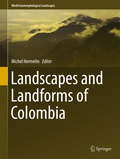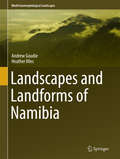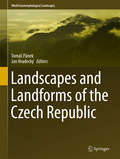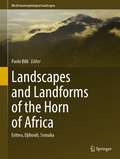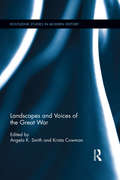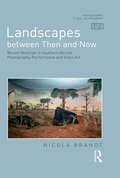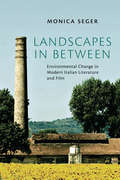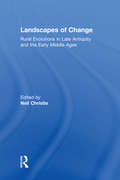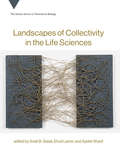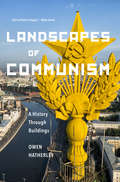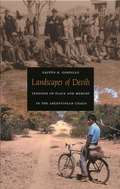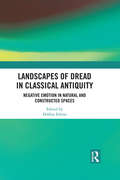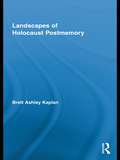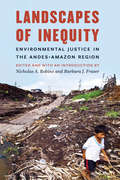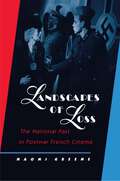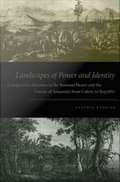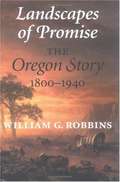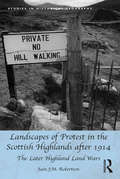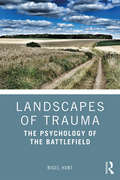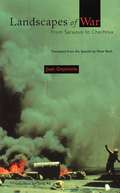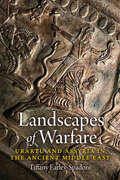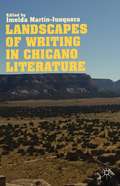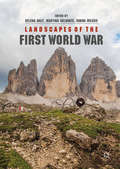- Table View
- List View
Landscapes and Landforms of Colombia
by Michel HermelinThis book provides an attractive and informative overview of Colombian landscapes and their geological evolution, including comprehensive descriptions of seventeen key selected sites in the country. It provides insight into the geomorphological diversity of Colombian landscapes characterized by climatic and topographic variation. The book covers the essence of the landscapes in the country: coastal features, mud volcanoes, desertic geoforms, snow covered peaks, active volcanoes, deeply incised canyons and subdesertic valleys. It contributes knowledge and understanding into Colombian landscapes and prospects.
Landscapes and Landforms of Namibia
by Andrew Goudie Heather VilesThe landscapes of Namibia are of world-class quality in beauty, diversity and interest. This book provides the first ever overview of the most important of these landscapes, explains why they look as they do, and evaluates why they are of note. Writing from a geomorphological perspective, the authors introduce the key processes and controls which influence landscape and landform development in Namibia. Geological and tectonic background, climate now and in the past, vegetation and animals (including humans) are all identified as crucial factors influencing the landscape of Namibia today. The book presents twenty one richly-illustrated case studies of the most significant landscapes of Namibia, ranging from the iconic Etosha Pan at the heart of the biggest wildlife conservation area in the north, to the famous dunes and ephemeral river at Sossus Vlei in the heart of the Namib desert. Each case study also contains a full list of the key references to the scientific work on that landscape. The authors provide an assessment of the current state of conservation of these landscapes, and their importance to tourism. The book is recommended reading for anyone with a professional or amateur interest in the spectacular and intriguing landscapes of this part of southern Africa. It provides a useful handbook for those travelling around Namibia, and an invaluable reference guide for those interested in how landscapes develop and change.
Landscapes and Landforms of the Czech Republic
by Tomáš Pánek Jan HradeckýThe book aims to present the unique geomorphological landscapes of the Czech Republic. The geomorphic uniqueness of this country benefits from the proximity to two distinct European geological domains: the old cratonized Bohemian Massif and the relatively young Tertiary fold and thrust belt of the Western Carpathians. Landscapes and Landforms of the Czech Republic introduces general physiographical characteristics of the landscape and presents the main driving factors leading to the evolution of the present landscape. The book contains twenty two chapters describing the most interesting geomorphic landscapes of the Czech Republic. The selection of individual landscapes was based on visual exceptionality (e. g. sandstone landscapes of the Northern Bohemia), scientific importance (e. g. patterned grounds in the Sudetic Mountains) and historical relevance (e. g. mining of the Nízký and Hrubý Jeseník Mountains). The final chapters of the book discuss the protection of geomorphic heritage in the Czech Republic.
Landscapes and Landforms of the Horn of Africa: Eritrea, Djibouti, Somalia (World Geomorphological Landscapes)
by Paolo BilliThis book focuses on regions for which until now the geomorphology was very poorly studied and relatively unknown. Nevertheless, the landforms and landscapes of the Horn of Africa are highly attractive, diverse and in a few cases unique, since they span very different environments, from highland plateaus and mountains to lowlands (even below sea level) and coastlines with a high degree of diversity and from monsoon to arid climate conditions. The main topics addressed in the book include the links between the geological evolution and the current large scale geomorphology of the Horn of Africa; the large differences between the highlands and lowlands climate, river hydrology and their variation through time within a climate change perspective. This part of the world was home of the very first hominids. The landscape in which they lived and evolved throughout the Pleistocene is described in comparison with the arid and inhospitable, though immensely scenic, environment of today. Perennial and ephemeral rivers with very different morphology, processes, and hydrology drain the area, and, in combination with the past and recent uplift, substantially contributed to provide the region with peculiar landscapes and landforms. Long lasting weathering and erosion processes result in a typical inselberg landscape such as the Bur region, or the currently exposed flatland of old peneplain surfaces. Their changes through time, induced by both natural and anthropogenic factors, are addressed by a couple of case studies. Though the region has few inhabitants, they had to struggle to find their livelihood in a land that offers poor resources. This resulted in landscape change and land degradation. Examples of human impact on the landscape are presented at different scales. This book provides readers interested in geography and geomorphology with essential scientific and educational information on the Landscapes and Landforms of Eritrea, Djibouti and Somalia through simple, though scientifically, rigorous texts illustrated with several color maps and photos. One main prerogative of this book is therefore to give an insight into a region of the world where, for geographical and historical constraints, geomorphological investigation was very limited, thus enriching its intrinsic informative value.
Landscapes and Voices of the Great War (Routledge Studies in Modern History #22)
by Angela K. Smith Krista CowmanThis volume aims to provide a wider view of First World War experience through focusing on landscapes less commonly considered in historiography, and on voices that have remained on the margins of popular understanding of the war. The landscape of the western front was captured during the conflict in many different ways: in photographs, paintings and print. The most commonly replicated voicing of contemporary attitudes towards the war is that of initial enthusiasm giving way to disillusionment and a sense of overwhelming futility. Investigations of the many components of war experience drawn from social and cultural history have looked to landscapes and voices beyond the frontline as a means of foregrounding different perspectives on the war. Not all of the voices presented here opposed the war, and not all of the landscapes were comprised of trenches or flanked by barbed wire. Collectively, they combine to offer further fresh insights into the multiplicity of war experience, an alternate space to the familiar tropes of mud and mayhem.
Landscapes between Then and Now: Recent Histories in Southern African Photography, Performance and Video Art (Photography, Place, Environment)
by Nicola BrandtIn Landscapes Between Then and Now, Nicola Brandt examines the increasingly compelling and diverse cross-disciplinary work of photographers and artists made during the transition from apartheid to post-apartheid and into the contemporary era. By examining specific artworks made in South Africa, Namibia and Angola, Brandt sheds light on established and emerging themes related to aftermath landscapes, embodied histories, (un)belonging, spirituality and memorialization. She shows how landscape and identity are mutually constituted, and profiles this process against the background of the legacy of the acutely racially divisive policies of the apartheid regime that are still reflected on the land. As a signpost throughout the book, Brandt draws on the work of the renowned South African photographer Santu Mofokeng and his critical thinking about landscape. Landscapes Between Then and Now explores how practitioners who engage with identity and their physical environment as a social product might reveal something about the complex and fractured nature of postcolonial and contemporary societies. Through diverse strategies and aesthetics, they comment on inherent structures and epistemologies of power whilst also expressing new and radical forms of self-determinism. Brandt asks why these cross-disciplinary works ranging from social documentary to experimental performance and embodied practices are critical now, and what important possibilities for social and political reflection and engagement they suggest.
Landscapes in Between
by Monica SegerSince its economic boom in the late 1950s, Italy has grappled with the environmental legacy of rapid industrial growth and haphazard urban planning. One notable effect is a preponderance of interstitial landscapes such as abandoned fields, polluted riverbanks, and makeshift urban gardens. Landscapes in Between analyses authors and filmmakers - Italo Calvino, Pier Paolo Pasolini, Gianni Celati, Simona Vinci, and the duo Daniele Ciprì and Franco Maresco - who turn to these spaces as productive models for coming to terms with the modified natural environment.Considering the ways in which sixty years' worth of Italian literary and cinematic representations engage in the ongoing dialogue between nature and culture, Monica Seger contributes to the transnational expansion of environmental humanities. Her book also introduces an ecocritical framework to Italian studies in English. Rejecting a stark dichotomy between human construction and unspoilt nature, Landscapes in Between will be of interest to all those studying the fraught relationship between humanity and environment.
Landscapes of Change: Rural Evolutions in Late Antiquity and the Early Middle Ages
by Neil ChristieOnly in recent years has archaeology begun to examine in a coherent manner the transformation of the landscape from classical through to medieval times. In Landscapes of Change, leading scholars in the archaeology of the late antique and early medieval periods address the key results and directions of Roman rural fieldwork. In so doing, they highlight problems of analysis and interpretation whilst also identifying the variety of transformations that rural Europe experienced during and following the decline of Roman hegemony. Whilst documents and standing buildings predominate in the urban context to provide a coherent and tangible guide to the evolving urban form and its society since Roman times, the countryside in many ages remains rather shadowy - a context for the cultivation, gathering and movement of food and other resources, inhabited by farmers, villagers and miners. Whilst the Roman period is adequately served through occasional extant remains and through the survey and excavation of villas and farmsteads, as well as the writings of agronomists, the medieval one is generally well marked by the presence of still extant villages across Europe, often dependent on castles and manors which symbolise the so-called 'feudal' centuries. But the intervening period, the fourth to tenth centuries, is that with the least documentation and with the fewest survivals. What happened to the settlement units that made up the Roman rural world? When and why do new settlement forms emerge? Landscapes of Change is essential reading for anyone wanting an up-to-date summary of the results of archaeological and historical investigations into the changing countryside of the late Roman, late antique and early medieval world, between the fourth and tenth centuries AD. It questions numerous aspects of change and continuity, assessing the levels of impact of military and economic decay, the spread and influence of Christianity, and the role of Germanic, Slav and Arab settlements in disrupting and redefining the ancient rural landscapes.
Landscapes of Collectivity in the Life Sciences (Vienna Series in Theoretical Biology #20)
by Ayelet Shavit Ehud Lamm Snait GissisBroad perspective on collectivity in the life sciences, from microorganisms to human consensus, and the theoretical and empirical opportunities and challenges. Many researchers and scholars in the life sciences have become increasingly critical of the traditional methodological focus on the individual. This volume counters such methodological individualism by exploring recent and influential work in the life sciences that utilizes notions of collectivity, sociality, rich interactions, and emergent phenomena as essential explanatory tools to handle numerous persistent scientific questions in the life sciences. The contributors consider case studies of collectivity that range from microorganisms to human consensus, discussing theoretical and empirical challenges and the innovative methods and solutions scientists have devised. The contributors offer historical, philosophical, and biological perspectives on collectivity, and describe collective phenomena seen in insects, the immune system, communication, and human collectivity, with examples ranging from cooperative transport in the longhorn crazy ant to the evolution of autobiographical memory. They examine ways of explaining collectivity, including case studies and modeling approaches, and explore collectivity's explanatory power. They present a comprehensive look at a specific case of collectivity: the Holobiont notion (the idea of a multi-species collective, a host and diverse microorganisms) and the hologenome theory (which posits that the holobiont and its hologenome are a unit of adaption). The volume concludes with reflections on the work of the late physicist Eshel Ben-Jacob, pioneer in the study of collective phenomena in living systems. Contributors Oren Bader, John Beatty, Dinah R. Davison, Daniel Dor, Ofer Feinerman, Raghavendra Gadagkar, Scott F. Gilbert, Snait B. Gissis, Deborah M. Gordon, James Griesemer, Zachariah I. Grochau-Wright, Erik R. Hanschen, Eva Jablonka, Mohit Kumar Jolly, Anat Kolumbus, Ehud Lamm, Herbert Levine, Arnon Levy, Xue-Fei Li, Elisabeth A. Lloyd, Yael Lubin, Eva Maria Luef, Ehud Meron, Richard E. Michod, Samir Okasha, Simone Pika, Joan Roughgarden, Eugene Rosenberg, Ayelet Shavit, Yael Silver, Alfred I. Tauber, Ilana Zilber-Rosenberg
Landscapes of Communism
by Owen HatherleyWhen communism took power in Eastern Europe it remade cities in its own image, transforming everyday life and creating sweeping boulevards and vast, epic housing estates in an emphatic declaration of a noncapitalist idea. The regimes that built them are now dead and long gone, but from Warsaw to Berlin, Moscow to postrevolutionary Kiev, the buildings remain, often populated by people whose lives were scattered by the collapse of communism.Landscapes of Communism is a journey of historical discovery, plunging us into the lost world of socialist architecture. Owen Hatherley, a brilliant, witty, young urban critic shows how power was wielded in these societies by tracing the sharp, sudden zigzags of official communist architectural style: the superstitious despotic rococo of high Stalinism, with its jingoistic memorials, palaces, and secret policemen's castles; East Germany's obsession with prefabricated concrete panels; and the metro systems of Moscow and Prague, a spectacular vindication of public space that went further than any avant-garde ever dared. Throughout his journeys across the former Soviet empire, Hatherley asks what, if anything, can be reclaimed from the ruins of Communism-what residue can inform our contemporary ideas of urban life?
Landscapes of Devils: Tensions of Place and Memory in the Argentinean Chaco
by Gastón R. GordilloLandscapes of Devils is a rich, historically grounded ethnography of the western Toba, an indigenous people in northern Argentina's Gran Chaco region. In the early twentieth century, the Toba were defeated by the Argentinean army, incorporated into the seasonal labor force of distant sugar plantations, and proselytized by British Anglicans. Gastn R. Gordillo reveals how the Toba's memory of these processes is embedded in their experience of "the bush" that dominates the Chaco landscape. As Gordillo explains, the bush is the result of social, cultural, and political processes that intertwine this place with other geographies. Labor exploitation, state violence, encroachment by settlers, and the demands of Anglican missionaries all transformed this land. The Toba's lives have been torn between alienating work in sugar plantations and relative freedom in the bush, between moments of domination and autonomy, abundance and poverty, terror and healing. Part of this contradictory experience is culturally expressed in devils, evil spirits that acquire different features in different places. The devils are sources of death and disease in the plantations, but in the bush they are entities that connect with humans as providers of bush food and healing power. Enacted through memory, the experiences of the Toba have produced a tense and shifting geography. Combining extensive fieldwork conducted over a decade, historical research, and critical theory, Gordillo offers a nuanced analysis of the Toba's social memory and a powerful argument that geographic places are not only objective entities but also the subjective outcome of historical forces.
Landscapes of Dread in Classical Antiquity: Negative Emotion in Natural and Constructed Spaces
by Debbie FeltonOver the last two decades, research in cultural geography and landscape studies has influenced many humanities fields, including Classics, and has increasingly drawn our attention to the importance of spaces and their contexts, both geographical and social: how spaces are described by language, what spaces are used for by individuals and communities, and how language, use, and the passage of time invest spaces with meaning. In addition to this ‘spatial’ turn in scholarship, recent years have also seen an ‘emotive’ turn – an increased interest in the study of emotion in literature. Many works on landscape in classical antiquity focus on themes such as the sacred and the pastoral and the emotions such spaces evoke, such as (respectively) feelings of awe or tranquillity in settings both urban and rural. Far less scholarship has been generated by the locus terribilis, the space associated with negative emotions because of the bad things that happen there. In short, the recent ‘emotive’ turn in humanities studies has so far largely neglected several of the more negative emotions, including anxiety, fear, terror, and dread. The papers in this volume focus on those neglected negative emotions, especially dread – and they do so while treating many types of space, including domestic, suburban, rural and virtual, and while covering many genres and authors, including the epic poems of Homer, Greek tragedy, Roman poetry and historiography, medical writing, paradoxography and the short story.
Landscapes of Fear
by Yi-Fu TuanTo be human is to experience fear, but what is it exactly that makes us fearful? Landscapes of Fear—written immediately after his classic Space and Place—is renowned geographer Yi-Fu Tuan&’s influential exploration of the spaces of fear and of how these landscapes shift during our lives and vary throughout history.In a series of linked essays that journey broadly across place, time, and cultures, Tuan examines the diverse manifestations and causes of fear in individuals and societies: he describes the horror created by epidemic disease and supernatural visions of witches and ghosts; violence and fear in the country and the city; fears of drought, flood, famine, and disease; and the ways in which authorities devise landscapes of terror to instill fear and subservience in their own populations. In this groundbreaking work—now with a new preface by the author—Yi-Fu Tuan reaches back into our prehistory to discover what is universal and what is particular in our inheritance of fear. Tuan emphasizes that human fear is a constant; it causes us to draw what he calls our &“circles of safety&” and at the same time acts as a foundational impetus behind curiosity, growth, and adventure.
Landscapes of Holocaust Postmemory (Routledge Research In Cultural And Media Studies #29)
by Brett Ashley KaplanHow do the spaces of the past stay with us through representations—whether literary or photographic? How has the Holocaust registered in our increasingly globally connected consciousness? What does it mean that this European event is often used as an interpretive or representational touchstone for genocides and traumas globally? In this interdisciplinary study, Kaplan asks and attempts to answer these questions by looking at historically and geographically diverse spaces, photographs, and texts concerned with the physical and/or mental landscape of the Holocaust and its transformations from the postwar period to the early twenty-first century. Examining the intersections of landscape, postmemory, and trauma, Kaplan's text offers a significant contribution to our understanding of the spatial, visual, and literary reach of the Holocaust.
Landscapes of Hope: Nature And The Great Migration In Chicago
by Brian McCammackIn the first interdisciplinary history to frame the African American Great Migration as an environmental experience, Brian McCammack travels to Chicago’s parks and beaches as well as farms and forests of the rural Midwest, where African Americans retreated to relax and reconnect with southern identities and lifestyles they had left behind.
Landscapes of Inequity: Environmental Justice in the Andes-Amazon Region
by Nicholas A. Robins Barbara J. FraserThe natural wealth of the Amazon and Andes has long attracted fortune seekers, from explorers, farmers, and gold panners to multimillion-dollar mining, oil and gas, and timber operations. Modern demands for commodities have given rise to new development schemes, including hydroelectric dams, open cast mines, and industrial agricultural operations. The history of human habitation in this region is intimately tied to its rich biodiversity, and the Amazon basin is home to scores of indigenous groups, many of whom have populations so small that their cultural and physical survival is endangered.Landscapes of Inequity explores the debate over rights to and use of resources and addresses fundamental questions that inform the debate in the western Amazon basin, from the Andes Mountains to the tropical lowlands. Beginning with an examination of the divergent conceptual interpretations of environmental justice, the volume explores the issue from two interlocking perspectives: of indigenous peoples and of economic development in a global economy. The volume concludes by examining the efficacy of laws and policies concerning the environment in the region, the viability and range of judicial recourse, and future directions in the field of environmental justice.
Landscapes of Loss: The National Past in Postwar French Cinema
by Naomi GreeneIn Landscapes of Loss, Naomi Greene makes new sense of the rich variety of postwar French films by exploring the obsession with the national past that has characterized French cinema since the late 1960s. Observing that the sense of grandeur and destiny that once shaped French identity has eroded under the weight of recent history, Greene examines the ways in which French cinema has represented traumatic and defining moments of the nation's past: the political battles of the 1930s, the Vichy era, decolonization, the collapse of ideologies. Drawing upon a broad spectrum of films and directors, she shows how postwar films have reflected contemporary concerns even as they have created images and myths that have helped determine the contours of French memory. This study of the intricate links between French history, memory, and cinema begins by examining the long shadow cast by the Vichy past: the repressed memories and smothered unease that characterize the cinema of Alain Resnais are seen as a kind of prelude to a fierce battle for national memory that marked so-called rétro films of the 1970s and 1980s. The shifting political and historical perspectives toward the nation's more distant past, which also emerged in these years, are explored in the light of the films of one of France's leading directors, Bertrand Tavernier. Finally, the mood of nostalgia and melancholy that appears to haunt contemporary France is analyzed in the context of films about the nation's imperial past as well as those that hark back to a "golden age," a remembered paradis perdu, of French cinema itself.
Landscapes of Power and Identity: Comparative Histories in the Sonoran Desert and the Forests of Amazonia from Colony to Republic
by Cynthia RaddingLandscapes of Power and Identity is a groundbreaking comparative history of two colonies on the frontiers of the Spanish empire--the Sonora region of northwestern Mexico and the Chiquitos region of eastern Bolivia's lowlands--from the late colonial period through the middle of the nineteenth century. An innovative combination of environmental and cultural history, this book reflects Cynthia Radding's more than two decades of research on Mexico and Bolivia and her consideration of the relationships between human societies and the geographic landscapes they inhabit and create. At first glance, Sonora and Chiquitos are quite different: one a scrub-covered desert, the other a tropical rainforest of the greater Amazonian and Paraguayan river basins. Yet the regions are similar in many ways. Both were located far from the centers of colonial authority, organized into Jesuit missions and linked to the principal mining centers of New Spain and the Andes, and then absorbed into nation-states in the nineteenth century. In each area, the indigenous communities encountered European governors, missionaries, slave hunters, merchants, miners, and ranchers. Radding's comparative approach illuminates what happened when similar institutions of imperial governance, commerce, and religion were planted in different physical and cultural environments. She draws on archival documents, published reports by missionaries and travelers, and previous histories as well as ecological studies and ethnographies. She also considers cultural artifacts, including archaeological remains, architecture, liturgical music, and religious dances. Radding demonstrates how colonial encounters were conditioned by both the local landscape and cultural expectations; how the colonizers and colonized understood notions of territory and property; how religion formed the cultural practices and historical memories of the Sonoran and Chiquitano peoples; and how the conflict between the indigenous communities and the surrounding creole societies developed in new directions well into the nineteenth century.
Landscapes of Promise: The Oregon Story, 1800-1940
by William G. Robbins William CrononBefore the first white trappers reached the Oregon country in the late 18th century, Native Americans had already had a profound impact on the landscape by regularly burning forest undergrowth to open grazing land for elk and deer. Europeans and Americans, however, viewed the land as a series of commercial opportunities and exploited resources they believed to be unlimited. Drawing upon newspaper accounts, journals, and a host of other primary sources, the author explores human activity in Oregon and the attitudes which affected it.
Landscapes of Protest in the Scottish Highlands after 1914: The Later Highland Land Wars (Studies In Historical Geography Ser.)
by Iain J.M. RobertsonIn November 1918, the implementation of agrarian change in the Scottish Highlands threatened another wave of unemployment and eviction for the land-working population, which led to widespread and varied social protest. Those who had been away on war service (and their families) faced returning to exactly the same social and economic conditions in the Scottish Highlands they had hoped they had left behind in the struggle to make ’a land fit for heroes’. Widespread and varied social protest rapidly followed. It argues that, previously, there has been a failure to capture fully the geography, chronology typology and rate of occurrence of these events. The book not only offers new insights and a greater understanding of what was happening in the Highlands in this period, but illustrates how a range of forms of protest were used which demand attention, not least for the fact that these events, unlike most of the earlier Land Wars period, were successful. There are functioning townships in the Highlands today that owe their existence to the land invasions of the 1920s. The book innovatively concentrates on formulating explanation and interpretation from within and looks to the crofting landscape as base, means and motive to disturbance and interpretation. It proposes that protest is much more convincingly understood as an expression of environmental ethics from 'the bottom up' coming increasingly into conflict with conservationist views expressed from 'the top down' It focuses on individual case studies in order to engage more convincingly with an important evidential base - that of popular memory of land disturbances - and to adopt a frame and lens through which to explore the fluid and contingent nature of protest performances. Based upon the belief that in the study of landscapes of social protest the old shibboleth of space as solely passive setting and symbolic register is no longer tenable is paid here to nature/culture interactions, to vernacular ecological b
Landscapes of Trauma: The Psychology of the Battlefield
by Nigel HuntIntegrating trauma studies with historical research and social psychology, Landscapes of Trauma examines a range of battlefields from across history, including Waterloo, the Battle of Sedan, the Battle of the Ebro and the Battle of Normandy, to bring to light what these battlefields say about our collective and individual psyches. Hunt explores how war shapes the nature of trauma, not only by its innate horror but also by the historical and societal contexts it is fought in, from the cultural and social conventions of the period to the topography of the settings. This book provides a deep analysis of how war is experienced and remembered in different eras and by different generations. Moving beyond the clinical concept of post-traumatic stress disorder, Hunt discusses how trauma can be understood socially and historically, as well as through the lens of individual suffering. This book also investigates the psychological foundations of memorialisation, remembrance and commemoration that shape the legacy of the battles discussed. Using interviews with veterans, their letters, journals and diaries, as well as literary and historical sources, Hunt locates the battlefield as a place where humans explore the parameters of human behaviour, thought and emotion. This book is in important resource for students and scholars interested in the psychology of trauma and war, as well as military history.
Landscapes of War: From Sarajevo to Chechnya
by Juan Goytisolo Peter BushAn incisive examination of the tensions that exist between the West and Islamic societies of Europe, North Africa, and the Middle East. Provides rich historical analysis and reportage of life in four explosive war-zones: Sarajevo, Algeria, the West Bank and Gaza, and Chechnya. Translated by Peter Bush.
Landscapes of Warfare: Urartu and Assyria in the Ancient Middle East
by Tiffany Earley-SpadoniLandscapes of Warfare offers an in-depth exploration of the Urartian empire, which occupied the highlands of present-day Turkey, Armenia, and Iran in the early first millennium BCE. Lesser known than its rival, the Neo-Assyrian empire, Urartu presents a unique case of imperial power distributed among mountain fortresses rather than centralized in cities. Through spatial analysis, the book demonstrates how systematic warfare, driven by imperial ambitions, shaped Urartian and Assyrian territories, creating symbolically and materially powerful landscapes. Tiffany Earley-Spadoni challenges traditional views by emphasizing warfare’s role in organizing ancient landscapes, suggesting that Urartu’s strength lay in its strategic optimization of terrain through fortified regional networks. Using an interdisciplinary approach that includes GIS-enabled studies and integrates archaeological, historical, and art-historical evidence, she illustrates how warfare was a generative force in structuring space and society in the ancient Middle East. Landscapes of Warfare situates Urartu’s developments within the broader context of regional empires, providing insights into the mechanisms of warfare, governance, and cultural identity formation.
Landscapes of Writing in Chicano Literature
by Imelda Martín-JunqueraAdding nuance to a global debate, esteemed scholars from Europe and North and Latin America portray the attempts in Chicano literature to provide answers to the environmental crisis. Diverse ecocritical perspectives add new meaning to the novels, short stories, drama, poetry, films, and documentaries analyzed in this timely and engaged collection.
Landscapes of the First World War
by Vanda Wilcox Selena Daly Martina SalvanteThis comparative and transnational study of landscapes in the First World War offers new perspectives on the ways in which landscapes were idealised, mobilised, interpreted, exploited, transformed and destroyed by the conflict. The collection focuses on four themes: environment and climate, industrial and urban landscapes, cross-cultural encounters, and legacies of the war. The chapters cover Europe, Russia, the Middle East, Africa and the US, drawing on a range of approaches including battlefield archaeology, military history, medical humanities, architecture, literary analysis and environmental history. This volume explores the environmental impact of the war on diverse landscapes and how landscapes shaped soldiers’ experiences at the front. It investigates how rural and urban locales were mobilised to cater to the demands of industry and agriculture. The enduring physical scars and the role of landscape as a crucial locus of memory and commemoration are also analysed. The chapter 'The Long Carry: Landscapes and the Shaping of British Medical Masculinities in the First World War' is open access under a CC BY 4.0 license via link.springer.com.
